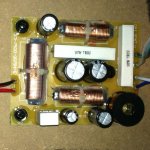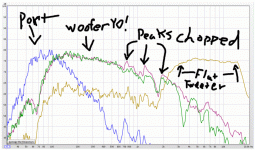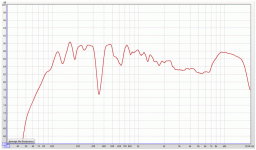Speaker: Infinity Primus P163
Crossover spec: 2-way, 3000Hz, 24dB per octave
Impedance: 8 ohms
The capacitor values and 2 of the resistor values are known.
C1 100V 13uF
C2 100V 100uF
C3 100V 33uF
C4 100V 4.7uF
C5 100V 24uF
Is it possible to deduce this circuit and the remaining component values?
Crossover spec: 2-way, 3000Hz, 24dB per octave
Impedance: 8 ohms
The capacitor values and 2 of the resistor values are known.
C1 100V 13uF
C2 100V 100uF
C3 100V 33uF
C4 100V 4.7uF
C5 100V 24uF
Is it possible to deduce this circuit and the remaining component values?
Attachments
Is it possible to deduce this circuit and the remaining component values?
Probably like this, but with a Zobel across the LF driver.
The tweeter parts are along the bottom edge of the board.
Looks like there is a 10R in series with the tweeter circuit.
Google Image Result for http://images.audiojudgement.com/2016/05/4th-order-linkwitz-riley.jpg
Last edited:
Not with 100% certainty, it would be much easier to measure the inductors which should get you close enough.
You will also need to ring out or trace the board in order to figure out the exact topology used.
You will also need to ring out or trace the board in order to figure out the exact topology used.
Ideally I should rip the crossover out, but it would render the speaker unusable. I will do this when I am ready to work on it, preferably when the required parts are on hand. But I don't know what is the required parts. So it is a chicken and egg dilemma. 😀
Probably like this, but with a Zobel across the LF driver.
The tweeter parts are along the bottom edge of the board.
Looks like there is a 10R in series with the tweeter circuit.
Google Image Result for http://images.audiojudgement.com/2016/05/4th-order-linkwitz-riley.jpg
If 4 caps and inductors forms the filter.
1 cap and resistor form a zobel network.
1 resistor in series with tweeter
That leaves us with 1 mystery resistor.
Edit: It could be the twin 7 ohm resistors paralleled as a single resistor to increase wattage. This may be used in series with the tweeter too, or is it more likely to be used on zobel network?
Last edited:
If 4 caps and inductors forms the filter. 1 cap and resistor form a zobel network.
1 resistor parallel with tweeter That leaves us with 1 mystery resistor.
One large resistor is part of the Zobel across the woofer, and the other large resistor
attenuates the tweeter.
Last edited:
One resistor is part of the Zobel across the woofer, and the other resistor attenuates the tweeter.
There are 3 resistors on board, the white box at the lower left is one I think.
There are 3 resistors on board, the white box at the lower left is one I think.
Yes, but it's hard to tell what that one does.
If I were you, I'd use this as a chance to learn how to analyze a speaker system, then re-think the entire crossover.
Based on this:
Infinity Primus P163 Review
the basic crossover is a real funky piece of work, but the drivers themselves are not too bad.
Best,
E
Based on this:
Infinity Primus P163 Review
the basic crossover is a real funky piece of work, but the drivers themselves are not too bad.
Best,
E
BTW, if you go down that road, you need to see it as investing in yourself, not your speakers. 🙂
If you do, then tons of good people here will pile on and help you.
Best,
E
If you do, then tons of good people here will pile on and help you.
Best,
E
Actually I am considering just that, I am thinking of at least partially rebuilding this, if not ditch it altogether and move it to before the amp.
If we are just building one according to the spec, with crossover point at 3000Hz, it doesn’t seem to be that hard? I’m trying to see if I am missing anything.
If we are just building one according to the spec, with crossover point at 3000Hz, it doesn’t seem to be that hard? I’m trying to see if I am missing anything.
Based on this:
Infinity Primus P163 Review
From the link above, it looks like the tweeter is wired with the wrong polarity.
I suggest Navy flip the tweeter wires and do an AB with the other speaker. If the speaker still doesn't sound right, then proceed to more drastic measures.
From the link above, it looks like the tweeter is wired with the wrong polarity.
I suggest Navy flip the tweeter wires and do an AB with the other speaker. If the speaker still doesn't sound right, then proceed to more drastic measures.
Please enlighten me, how can you tell it is reversed?
I hope it's alright to copy the plots from nonaudiophile website. If there are any copyright issues, I'll appreciate the moderators help to remove them.
In the first plot, the woofer and tweeter are crossing at about 2.2kHz acoustically.
In the 2nd plot, which is the summed response, a huge chunk of frequencies are missing from 2.2kHz to 7kHz. This indicates severe phase cancellations.
Hopefully, when the tweeter polarity is flipped, it will restore the missing frequencies.
Even then, I doubt they will cross optimally. Phase cancellations will still occur due to the difference in acoustic centers of the woofer and tweeter but the summed response should be much better than what is shown in the 2nd plot now.
In the first plot, the woofer and tweeter are crossing at about 2.2kHz acoustically.
In the 2nd plot, which is the summed response, a huge chunk of frequencies are missing from 2.2kHz to 7kHz. This indicates severe phase cancellations.
Hopefully, when the tweeter polarity is flipped, it will restore the missing frequencies.
Even then, I doubt they will cross optimally. Phase cancellations will still occur due to the difference in acoustic centers of the woofer and tweeter but the summed response should be much better than what is shown in the 2nd plot now.
Attachments
I hope it's alright to copy the plots from nonaudiophile website. If there are any copyright issues, I'll appreciate the moderators help to remove them.
In the first plot, the woofer and tweeter are crossing at about 2.2kHz acoustically.
In the 2nd plot, which is the summed response, a huge chunk of frequencies are missing from 2.2kHz to 7kHz. This indicates severe phase cancellations.
Hopefully, when the tweeter polarity is flipped, it will restore the missing frequencies.
Even then, I doubt they will cross optimally. Phase cancellations will still occur due to the difference in acoustic centers of the woofer and tweeter but the summed response should be much better than what is shown in the 2nd plot now.
Thank you, that was enlightening. So either this is Infinty's design choice, or the review copy is wired wrong.
In the review, the speaker sound like plenty of bass and treble but very little vocals. In fact, the vocals don't stand out at all.
If your speakers sound this way, chances are they left the factory like that. I don't think it's bad design on the part of Infinity. More like bad QC.
I had the same issue once back in the 90s. I bought a pair of small 2-way Wharfedales, the one that's trapezoid in cross section with a formica marble top. I can't remember the model but the audio magazines were raving about them.
Played some music and the sound was bothering me. I eventually did a frequency sweep and true enough, the tweeter was out of phase. I rewired the tweeter and the crossover summed properly.
These things happen especially when they are manufactured in China. Maybe it's better today but in the early years, I was told you have to literally squat there to make sure the factory do it right.
If your speakers sound this way, chances are they left the factory like that. I don't think it's bad design on the part of Infinity. More like bad QC.
I had the same issue once back in the 90s. I bought a pair of small 2-way Wharfedales, the one that's trapezoid in cross section with a formica marble top. I can't remember the model but the audio magazines were raving about them.
Played some music and the sound was bothering me. I eventually did a frequency sweep and true enough, the tweeter was out of phase. I rewired the tweeter and the crossover summed properly.
These things happen especially when they are manufactured in China. Maybe it's better today but in the early years, I was told you have to literally squat there to make sure the factory do it right.
I don’t find the vocal missing though. I used this for watching TV and movies for years, I think they are great. The lower treble bump helps speech clarity.
Then I moved this to my music room, I think this lower treble bump made it fatiguing for longer listening session. So this made me want to buy new speaker, or modify this to my taste.
Then I moved this to my music room, I think this lower treble bump made it fatiguing for longer listening session. So this made me want to buy new speaker, or modify this to my taste.
That's not surprising. Music is more demanding. The fact that you find music fatiguing with your speakers indicates a closer examination is required.
Listening fatigue is generally caused by too much frequencies somewhere in the mids or highs. Another cause is cone breakup, particularly with metal cones.
I recently tested a Fountek FE85 3" full range woofer. I could hear the treble hardening on some music. And this is not even playing loud. That hardness sounds very much like from the cone breakup.
Try to find a way to do a frequency sweep of your speakers. Even a simple sweep can tell you a lot.
Listening fatigue is generally caused by too much frequencies somewhere in the mids or highs. Another cause is cone breakup, particularly with metal cones.
I recently tested a Fountek FE85 3" full range woofer. I could hear the treble hardening on some music. And this is not even playing loud. That hardness sounds very much like from the cone breakup.
Try to find a way to do a frequency sweep of your speakers. Even a simple sweep can tell you a lot.
- Status
- Not open for further replies.
- Home
- Loudspeakers
- Multi-Way
- Is it possible to deduce this crossover circuit?


